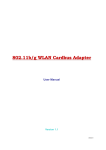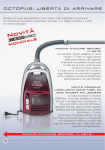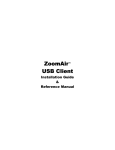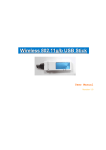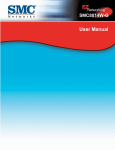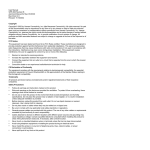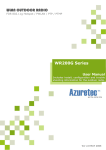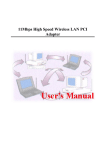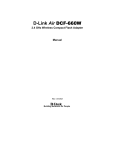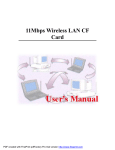Download D-Link DCF 650W (DCF-650W/20) Wireless Adapter
Transcript
DCF-650W Wireless Compact Flash Card Manual Table of Contents Introduction .........................................................................3 Features and Benefits.....................................................3 Wireless Solutions ..........................................................4 Contents of Package ..........................................................5 System Requirements ........................................................6 Wireless Basics...................................................................6 Network Topology ...........................................................8 Ad-Hoc Wireless Network ........................................................................8 Infrastructure Wireless Network .............................................................9 Wireless LAN Settings......................................................10 Using the Wireless LAN Utility on the DCF-650W ........10 Troubleshooting................................................................13 Specifications for DCF-650W ...........................................14 Contacting Technical Support .........................................16 Limited Warranty...............................................................16 Registration........................................................................19 2 Introduction The D-Link Air DCF-650W is an IEEE 802.11b Wireless Compact Flash Adapter that uses a standard Type II CF adapter interface. It provides the easiest and fastest way to access the Internet via wireless network. The Wireless Compact Flash technology in the DCF-650W allows the user to easily install in devices such as PDAs (Personal Digital Assistants) or other devices equipped with a Type II CF slot. The D-Link DCF-650W is 802.11b compliant and capable of connecting at data rates of up to 11Mbps.* The 11Mbps capability of the DCF-650W is comparable to existing Ethernet network setting and provides the user the necessary bandwidth to access and download files directly from the Internet or a Local Area Network environment. Features and Benefits 1. Supports 1, 2, 5.5 and 11 Mbps data rates 2. Working range is up to 800 ft. in an open environment 3. Supports point-to-point and point-to-multipoint access 4. Seamless connectivity to wired Ethernet and PC network LANs augments existing networks quickly and easily 5. Direct Sequence Spread Spectrum (DSSS) technology provides robust, interference-resistant, and secure wireless connection 6. Wireless connection without the cost of cabling 7. Supports WinCE 3.0 Handheld/Pocket PC 8. Supports high security WEP encryption (64-bit and 128-bit) 9. Supports Plug and Play 10. Easy Step-by-Step installation *Maximum wireless signal rate based on IEEE Standard 802.11b specifications. Actual data throughput will vary. Network conditions and environmental factors, including volume of network traffic, building materials and construction, and network overhead lower actual data throughput rate. 3 Wireless Solutions IEEE 802.11b Wireless LAN products offer a fast, reliable, cost-effective solution for wireless client access to the network in applications like these: 1. Remote access to corporate network information E-mail access, file transfers and terminal emulation. 2. Difficult-to-wire environments Historical or old buildings, asbestos installations, and open areas where wiring is difficult to deploy. 3. Frequently changing environments Retailers, manufacturers, and companies that requires constant change in the working environment and locations. 4. Temporary LANs for special projects or peak time • Trade shows, exhibitions, and construction sites that require a temporary network. • Retailers, airlines, and shipping companies needing additional workstations during peak periods. • 5. Auditors that may set up workgroups at customer sites. Access to database for mobile workers Doctors, nurses, and retailers, may access their databases while maintaining mobility in the hospital or retail stores. 6. Small Office/Home Office users Provides an easy and quick installation of a computer network. 7. High security connection The secure wireless network is installed quickly and provides flexibility. 4 Contents of Package DCF-650W High Speed Wireless Compact Flash Card Package Contents • DCF-650W 11 Mbps High Speed Wireless LAN Compact Flash Card • Manual on CD • Quick Install Guide Printed and also on CD • Acrobat® Reader • Pocket PC Utility Program 5 System Requirements In order to use the D-Link Air DCF-650W Wireless Compact Flash Adapter, the desktop or laptop computer used to “sync” the PDA must be equipped with the following: “Microsoft Active Sync” software (Software that came with your PDA) Wireless Basics Your new D-Link Air product is based on industry standards to provide easy to use and compatible high-speed wireless connectivity within your home or business. Strictly adhering to IEEE 802.11b, the D-Link Air family of products will allow you to access the data you want, when and where you want it. No longer will you be tethered to a workstation or forced to run new wiring. You will be able to enjoy the freedom that wireless networking delivers. Standards Based Technology Based on IEEE 802.11b, D-Link Air products can perform up to 11 Megabits per second. This means you will be able to transfer large files quickly or even watch a Movie in MPEG format over your network without noticeable delays. This technology works by using multiple frequencies in the 2.4GHz range utilizing Direct Sequence Spread Spectrum (DSSS) technology. D-Link Air products will automatically sense the best possible connection speed to ensure the greatest speed and range possible with the technology. Installation Considerations Designed to go up to 800 feet in an open environment, the D-Link DCF-650W lets you access your network from anywhere you want. However, keep in mind, that the effective range of any wireless product will be limited by the number of walls, ceilings, or other objects that the wireless signals must pass through. Typical ranges may vary depending on the types of materials and background RF noise in your home or business. The key to maximizing range is to follow these basic principles: 1. Keep the number of walls and ceilings to a minimum - Each wall or ceiling can reduce the effective range of D-Link Air Wireless product by a distance of three to ninety feet. Position your Access Points, Residential Gateways, and computers so that the number of walls or ceilings is minimized. 2. Be aware of the direct line between Access Points, Residential Gateways, and Computers - A wall that is 1.5 feet thick, at a 45 degree angle, appears to be almost 3 feet thick. At a 2-degree angle it looks over 42 feet thick! Try to make sure that the Access Point and Adapters are positioned so that the signal 6 will travel straight through a wall or ceiling for better reception. 3. Building Materials make a difference - A solid metal door or aluminum studs may have a negative effect on range. Try to position Access Points, Residential Gateways, and Computers so that the signal passes through drywall or open doorways and not other materials. 4. Make sure that the antenna is positioned for best reception by using the software signal strength tools included with your product. 5. Keep your product away (at least 3-6 feet) from electrical devices that generate RF noise, like microwaves, monitors, electric motors, etc. For the average American home, range should not be a problem. If you experience low or no signal strength in areas of your home that you wish to access, consider positioning the Access Point in a location directly between the Residential Gateways and/or Computers that will be connected. Additional Access Points can be connected to provide better coverage in rooms where the signal does not appear as strong as desired. Network Configuration The D-Link Air products support the same network configuration options as defined by IEEE 802 standard committee. The D-Link Air DCF-650W Wireless Compact Flash Card can be configured as: • Ad-Hoc for departmental or Small Business/Home Office LANs • Infrastructure for enterprise LANs • LAN-Interconnection for point-to-point link as a campus backbone 7 Network Topology Ad-Hoc Wireless Network An Ad-Hoc wireless LAN is a group of computers as well as PDAs that are equipped with a wireless adapter, connected as an independent wireless LAN (Local Area Network). Computers in a specific Ad-Hoc wireless LAN must be configured to the same radio channel. Ad-Hoc wireless LAN is applicable at a departmental scale for a branch or for Small Business/Home Office application. Note that 802.11 Ad-Hoc is a version of Ad-Hoc that allows wireless adapters from different manufacturers to work, but requires that both the radio channel and ESSID is the same for each computer or PDA. 8 Infrastructure Wireless Network The D-Link Air DCF-650W provides access to a wired LAN through the wireless extension of the local network. An integrated wireless and wired LAN using the deployment of Access Points is called an Infrastructure configuration. A group of wireless LAN PC users and an Access Point construct a Basic Service Set (BSS). Each wireless-equipped PC or PDA in this BSS will be able to communicate to any computer in the wired LAN infrastructure via the Access Point. Infrastructure configuration will extend the accessibility of a wireless station or PDA (Personal Digital Assistant) to the wired LAN. Multiple Access Points will allow roaming and will increase the effective transmission range. Also, the Access Point is capable of forwarding data within its Basic Service Set. Consequently, the effective transmission range in an infrastructure LAN is doubled with the introduction of wireless products into a local wired network. 9 Wireless LAN Settings Using the Wireless LAN Utility on the DCF-650W Note: The DCF-650W Wireless Compact Flash Adapter is a “ready-to-use” device. Its default settings are compatible with a typical Infrastructure Wireless LAN. If you choose to adjust the settings, please see the following instructions: On your PDA, go to Start > Settings> “System” tab Click on “DCF-650W CF Card” The “INFO” tab The “INFO” tab displays the Wireless Compact Flash Adapter’s current status and includes information on the following items: Adapter - Displays the name of the Wireless Compact Flash Adapter Firmware – Displays the firmware version that is equipped with your hardware Domain – The regulated operating frequency per country Channel – Displays the current channel that the Wireless Compact Flash is using MAC Address – The hardware identification number that distinguishes the unit from others 10 BSSID - Shows the MAC address of the Access Point that is associated with the Wireless LAN Compact Flash Adapter ESSID – Displays the Access Point that is associated with the Wireless LAN Compact Flash Adapter (Extended Service Set Identifier that identifies the wireless LAN) Link Quality – Monitors the quality of the data transmission between the Wireless Compact Flash adapter and the Access point Signal Level – This bar graph displays signal strength as reported by the radio, averaged over all frames that are received from the Access Point The “CONFIGURE” tab At the “CONFIGURE” tab you can view current settings for: ESSID – The ESSID is a unique ID given to the Access Point. Wireless clients using the same Access Point, must have the same ESSID as the Access Point. Note: Specifying an ESSID will prevent you from inadvertently connecting to a different wireless network. Network Type – Use “Infrastructure” mode if you will be using an Access Point in your network. Use “ad-hoc”, if you will not be using an Access Point. Ad-hoc requires the same channel and the same ESSID for all computers on the network. 802.11 Ad-hoc acquires the same channel and ESSID among all wireless stations. PS Mode – The “Power Save” mode is used to save battery life while the Wireless Compact Flash Adapter goes into sleep mode. Note: In “Power Save” mode, the Access Points used must support “Power Saving” for communication to be established. Tx Rate – The default transfer rate of “Fully Auto” or “Auto rate” is the most efficient choice since it will allow the DCF-650W to adjust to the most optimal transfer rate available. However, options are provided for setting a fixed transfer rate. You may make modifications to these settings if needed. Click Modify after you made the necessary changes. 11 The “LINK” tab The “LINK” tab is similar to the Ping Command used in computers to verify Ethernet connection is established. It allows you to monitor transmission quality between two stations. Enter the IP address of another station, set the timeout and packet size to see if the communication was sent successfully. The “WEP” tab If an additional measure of security is desired on the wireless network, WEP (Wired Equivalent Privacy) encryption can be enabled. Please select “Enable” in the above screen, if you wish to activate encryption. To activate WEP encryption, you will also need to select the “Key Length.” You may select either “64 Bits” or “128 Bits.” Please choose the “Key Length” that is the same as your Access Point. (Please refer to the manual for your Access Point to find the information). Input 4 different “Key Settings” in the fields provided. For 64 Bits WEP encryption, you may enter 5 characters in the range of “a-z”, “A-Z” and “0-9” (for example: MyKey); or a 10 digit hexadecimal value in the range “A-F”, “a-f”, and “0-9.”(For example: 11AA22BB33). For 128 Bits WEP encryption, you will enter 13 characters in the range of “a-z”, “A-Z” and “0-9” (for example: MyKey12345678); or 26 digit hexadecimal number for 128-bit encryption. If the number is entered incorrectly the function will not work. Note: The Key Settings must match the Access Point for proper operation. After entering the WEP keys, choose the WEP key you wish to use and click “Apply” for the configuration to take effect. 12 Troubleshooting Tips to Configure Your PDA for accessing the Internet To Configure the following: The Access Point’s ESSID WEP keys (if required) DHCP/Fixed IP (under IE browser) Go to: Settings>System>Wireless LAN Setting>Configure Settings>System>Wireless LAN Settings>WEP Setting>Connections>Network (select the Wireless LAN CF Card. Set the IP Address and Name Servers accordingly.) IP Addresses for device, Proxy server (under IE browser) Tools>Options>Connections (enter desired If DNS, WINS is needed (most IP addresses are automatically assigned.) (Under IE browser) Tools>Internet Proxy’s IP address and port#.) Options>Connections (enter desired Proxy address and port #.) After you shut down your PDA, “power on” the PDA again. It will open to the last application in use when it was “shut down.” If you are unable to navigate out of the “utility” program, you may use the PDA’s reset button to terminate the program. You can activate it again when needed. If your wireless connection to the Access Point gets disconnected for any reason, you can reset and force a connection request by going to the utility program, selecting "Configure," checking parameters, then selecting "Modify" to force a re-scan. If your device roams to a new Access Point which is in a different subnet, you may need to do one or both of the following: (1) Unplug and re-insert the Wireless LAN Compact Flash Adapter, or (2) Hard reset your device to force a "release and renew" of a re-assignment of the IP address in a DHCP Access Point environment. 13 Specifications for DCF-650W Standards • IEEE 802.11b Host interface • Compact Flash V1.4, CF+ I/O interface, Type II Protocols • TCP/IP Data Security • 64/128-bit WEP (Wired Equivalent Privacy) Encryption Data Rates* & Modulation • 11Mbps: CCK • 5.5Mbps: CCK • 2Mbps: DQPSK • 1Mpbs: DBSK • Auto Fall-Back Range Coverage (Open Environment) • 460 feet @ 11Mbps • 656 feet @ 5.5Mbps • 885 feet @ 2Mbps • 1311 feet @ 1Mbps Supported OS • Windows CE version 3.0 Diagnostic LED • Power, Link Power Consumption • TX power consumption: <380mA • RX power consumption: <280mA • Sleep Mode power consumption: 170mA Output Power • 14 dBm (Max. 18dBm) Voltage • 3.3 VDC+-10% Network Architecture Types • Supports Ad-Hoc and Infrastructure, 802.11 Ad-Hoc • Roaming (standard IEEE 802.11 compliant) Operating Channels • 11 United States (FCC) • 11 Canada (DOC) 14 Antenna • PIFA (Patched Inverse “F” Antenna) Type Antenna Sensitivity @ PER<0.08 • 11Mbps < -80dBm • 5.5Mbps < -83dBm • 2 Mbps < -86dBm • 1 Mbps < -88dBm Frequency Range • 2.412-2.462 GHz, Direct Sequence Spread Spectrum (DSSS) Temperature • Operating Temperature 0 ~ 55°C • Storage Temperature -20 ~ 80 °C Humidity • 5~90% Non-condensing Physical Dimensions • L = 3.25 inches • W= 2.31 inches • H= 0.44 inches • Weight = 0.06 lbs. Compatibility Pocket PC Compaq iPAQ (CPU: Strong ARM) Casio E115 and E125 (MIPS R4000) Handheld PC Sharp Telios (MIPS R3000) HP Jornada 720 (Strong ARM) Intel Pentium/X86 CPU Warranty • One Year Limited Warranty *Check http://www.dlink.com for newest releases of drivers. *Maximum wireless signal rate based on IEEE Standard 802.11b specifications. Actual data throughput will vary. Network conditions and environmental factors, including volume of network traffic, building materials and construction, and network overhead lower actual data throughput rate. 15 Contacting Technical Support You can find the most recent software and user documentation on the D-Link website. D-Link provides free technical support for customers within the United States during the warranty period on this product. U.S. customers can contact D-Link Technical Support through our web site, by e-mail or by phone. D-Link Technical Support over Telephone: (800) 758-5489 24 hours a day, seven days a week. D-Link Technical Support over the Internet: http://support.dlink.com 16 Subject to the terms and conditions set forth herein, D-Link Systems, Inc. (“D-Link”) provides this Limited Warranty: • • Only to the person or entity that originally purchased the product from D-Link or its authorized reseller or distributor, and Only for products purchased and delivered within the fifty states of the United States, the District of Columbia, U.S. Possessions or Protectorates, U.S. Military Installations, or addresses with an APO or FPO. Limited Warranty: D-Link warrants that the hardware portion of the D-Link product described below (“Hardware”) will be free from material defects in workmanship and materials under normal use from the date of original retail purchase of the product, for the period set forth below (“Warranty Period”), except as otherwise stated herein. • • • Hardware (excluding power supplies and fans): One (1) year Power supplies and fans: One (1) year Spare parts and spare kits: Ninety (90) days The customer's sole and exclusive remedy and the entire liability of D-Link and its suppliers under this Limited Warranty will be, at D-Link’s option, to repair or replace the defective Hardware during the Warranty Period at no charge to the original owner or to refund the actual purchase price paid. Any repair or replacement will be rendered by D-Link at an Authorized D-Link Service Office. The replacement hardware need not be new or have an identical make, model or part. D-Link may, at its option, replace the defective Hardware or any part thereof with any reconditioned product that D-Link reasonably determines is substantially equivalent (or superior) in all material respects to the defective Hardware. Repaired or replacement hardware will be warranted for the remainder of the original Warranty Period or ninety (90) days, whichever is longer, and is subject to the same limitations and exclusions. If a material defect is incapable of correction, or if D-Link determines that it is not practical to repair or replace the defective Hardware, the actual price paid by the original purchaser for the defective Hardware will be refunded by D-Link upon return to D-Link of the defective Hardware. All Hardware or part thereof that is replaced by D-Link, or for which the purchase price is refunded, shall become the property of D-Link upon replacement or refund. Limited Software Warranty: D-Link warrants that the software portion of the product (“Software”) will substantially conform to D-Link’s then current functional specifications for the Software, as set forth in the applicable documentation, from the date of original retail purchase of the Software for a period of ninety (90) days (“Software Warranty Period”), provided that the Software is properly installed on approved hardware and operated as contemplated in its documentation. D-Link further warrants that, during the Software Warranty Period, the magnetic media on which D-Link delivers the Software will be free of physical defects. The customer's sole and exclusive remedy and the entire liability of D-Link and its suppliers under this Limited Warranty will be, at D-Link’s option, to replace the non-conforming Software (or defective media) with software that substantially conforms to D-Link’s functional specifications for the Software or to refund the portion of the actual purchase price paid that is attributable to the Software. Except as otherwise agreed by D-Link in writing, the replacement Software is provided only to the original licensee, and is subject to the terms and conditions of the license granted by D-Link for the Software. Replacement Software will be warranted for the remainder of the original Warranty Period and is subject to the same limitations and exclusions. If a material non-conformance is incapable of correction, or if D-Link determines in its sole discretion that it is not practical to replace the non-conforming Software, the price paid by the original licensee for the non-conforming Software will be refunded by D-Link; provided that the non-conforming Software (and all copies thereof) is first returned to DLink. The license granted respecting any Software for which a refund is given automatically terminates. Non-Applicability of Warranty: The Limited Warranty provided hereunder for Hardware and Software portions of D-Link's products will not be applied to and does not cover any refurbished product and any product purchased through the inventory clearance or liquidation sale or other sales in which D-Link, the sellers, or the liquidators expressly disclaim their warranty obligation pertaining to the product and in that case, the product is being sold "As-Is" without any warranty whatsoever including, without limitation, the Limited Warranty as described herein, notwithstanding anything stated herein to the contrary. Submitting A Claim: The customer shall return the product to the original purchase point based on its return policy. In case the return policy period has expired and the product is within warranty, the customer shall submit a claim to D-Link as outlined below: • The customer must submit with the product as part of the claim a written description of the Hardware defect or Software nonconformance in sufficient detail to allow D-Link to confirm the same, along with proof of purchase of the product (such as a copy of the dated purchase invoice for the product) if the product is not registered. • The customer must obtain a Case ID Number from D-Link Technical Support at 1-877-453-5465, who will attempt to assist the customer in resolving any suspected defects with the product. If the product is considered defective, the customer must obtain a Return Material Authorization (“RMA”) number by completing the RMA form and entering the assigned Case ID Number at https://rma.dlink.com/. • After an RMA number is issued, the defective product must be packaged securely in the original or other suitable shipping package to ensure that it will not be damaged in transit, and the RMA number must be prominently marked on the outside of the package. Do not include any manuals or accessories in the shipping package. D-Link will only replace the defective portion of the product and will not ship back any accessories. • The customer is responsible for all in-bound shipping charges to D-Link. No Cash on Delivery (“COD”) is allowed. Products sent COD will either be rejected by D-Link or become the property of D-Link. Products shall be fully insured by the customer and shipped to D-Link Systems, Inc., 17595 Mt. Herrmann, Fountain Valley, CA 92708. D-Link will not be held responsible for any packages that are lost in transit to D-Link. The repaired or replaced packages will be shipped to the customer via UPS Ground or any common carrier selected by D-Link. Return shipping charges shall be prepaid by DLink if you use an address in the United States, otherwise we will ship the product to you freight collect. Expedited shipping is available upon request and provided shipping charges are prepaid by the customer. D-Link may reject or return any product that is not packaged and shipped in strict compliance with the foregoing requirements, or for which an RMA number is not visible from the outside of the package. The product owner agrees to pay D-Link’s reasonable handling and return shipping charges for any product that is not packaged and shipped in accordance with the foregoing requirements, or that is determined by D-Link not to be defective or non-conforming. What Is Not Covered: The Limited Warranty provided herein by D-Link does not cover: Products that, in D-Link’s judgment, have been subjected to abuse, accident, alteration, modification, tampering, negligence, misuse, faulty installation, lack of reasonable care, repair or service in any way that is not contemplated in the documentation for the product, or if the model or serial number has been altered, tampered with, defaced or removed; Initial installation, installation and removal of the product for repair, and shipping costs; Operational adjustments covered in the operating manual for the product, and normal maintenance; Damage that occurs in shipment, due to act of God, failures due to power surge, and cosmetic damage; Any hardware, software, firmware or other products or services provided by anyone other than D-Link; and Products that have been purchased from inventory clearance or liquidation sales or other sales in which D-Link, the sellers, or the liquidators expressly disclaim their warranty obligation pertaining to the product. While necessary maintenance or repairs on your Product can be performed by any company, we recommend that you use only an Authorized D-Link Service Office. Improper or incorrectly performed maintenance or repair voids this Limited Warranty. Disclaimer of Other Warranties: EXCEPT FOR THE LIMITED WARRANTY SPECIFIED HEREIN, THE PRODUCT IS PROVIDED “AS-IS” WITHOUT ANY WARRANTY OF ANY KIND WHATSOEVER INCLUDING, WITHOUT LIMITATION, ANY WARRANTY OF MERCHANTABILITY, FITNESS FOR A PARTICULAR PURPOSE AND NON-INFRINGEMENT. IF ANY IMPLIED WARRANTY CANNOT BE DISCLAIMED IN ANY TERRITORY WHERE A PRODUCT IS SOLD, THE DURATION OF SUCH IMPLIED WARRANTY SHALL BE LIMITED TO THE DURATION OF THE APPLICABLE WARRANTY PERIOD SET FORTH ABOVE. EXCEPT AS EXPRESSLY COVERED UNDER THE LIMITED WARRANTY PROVIDED HEREIN, THE ENTIRE RISK AS TO THE QUALITY, SELECTION AND PERFORMANCE OF THE PRODUCT IS WITH THE PURCHASER OF THE PRODUCT. Limitation of Liability: TO THE MAXIMUM EXTENT PERMITTED BY LAW, D-LINK IS NOT LIABLE UNDER ANY CONTRACT, NEGLIGENCE, STRICT LIABILITY OR OTHER LEGAL OR EQUITABLE THEORY FOR ANY LOSS OF USE OF THE PRODUCT, INCONVENIENCE OR DAMAGES OF ANY CHARACTER, WHETHER DIRECT, SPECIAL, INCIDENTAL OR CONSEQUENTIAL (INCLUDING, BUT NOT LIMITED TO, DAMAGES FOR LOSS OF GOODWILL, LOSS OF REVENUE OR PROFIT, WORK STOPPAGE, COMPUTER FAILURE OR MALFUNCTION, FAILURE OF OTHER EQUIPMENT OR COMPUTER PROGRAMS TO WHICH D-LINK’S PRODUCT IS CONNECTED WITH, LOSS OF INFORMATION OR DATA CONTAINED IN, STORED ON, OR INTEGRATED WITH ANY PRODUCT RETURNED TO D-LINK FOR WARRANTY SERVICE) RESULTING FROM THE USE OF THE PRODUCT, RELATING TO WARRANTY SERVICE, OR ARISING OUT OF ANY BREACH OF THIS LIMITED WARRANTY, EVEN IF D-LINK HAS BEEN ADVISED OF THE POSSIBILITY OF SUCH DAMAGES. THE SOLE REMEDY FOR A BREACH OF THE FOREGOING LIMITED WARRANTY IS REPAIR, REPLACEMENT OR REFUND OF THE DEFECTIVE OR NON-CONFORMING PRODUCT. THE MAXIMUM LIABILITY OF D-LINK UNDER THIS WARRANTY IS LIMITED TO THE PURCHASE PRICE OF THE PRODUCT COVERED BY THE WARRANTY. THE FOREGOING EXPRESS WRITTEN WARRANTIES AND REMEDIES ARE EXCLUSIVE AND ARE IN LIEU OF ANY OTHER WARRANTIES OR REMEDIES, EXPRESS, IMPLIED OR STATUTORY. Governing Law: This Limited Warranty shall be governed by the laws of the State of California. Some states do not allow exclusion or limitation of incidental or consequential damages, or limitations on how long an implied warranty lasts, so the foregoing limitations and exclusions may not apply. This Limited Warranty provides specific legal rights and you may also have other rights which vary from state to state. Trademarks: D-Link is a registered trademark of D-Link Systems, Inc. Other trademarks or registered trademarks are the property of their respective owners. Copyright Statement: No part of this publication or documentation accompanying this product may be reproduced in any form or by any means or used to make any derivative such as translation, transformation, or adaptation without permission from D-Link Corporation/D-Link Systems, Inc., as stipulated by the United States Copyright Act of 1976 and any amendments thereto. Contents are subject to change without prior notice. Copyright 2005 by D-Link Corporation/D-Link Systems, Inc. All rights reserved. CE Mark Warning: This is a Class B product. In a domestic environment, this product may cause radio interference, in which case the user may be required to take adequate measures. FCC Statement: This equipment has been tested and found to comply with the limits for a Class B digital device, pursuant to part 15 of the FCC Rules. These limits are designed to provide reasonable protection against harmful interference in a residential installation. This equipment generates, uses, and can radiate radio frequency energy and, if not installed and used in accordance with the instructions, may cause harmful interference to radio communication. However, there is no guarantee that interference will not occur in a particular installation. If this equipment does cause harmful interference to radio or television reception, which can be determined by turning the equipment off and on, the user is encouraged to try to correct the interference by one or more of the following measures: • • • • Reorient or relocate the receiving antenna. Increase the separation between the equipment and receiver. Connect the equipment into an outlet on a circuit different from that to which the receiver is connected. Consult the dealer or an experienced radio/TV technician for help. For detailed warranty information applicable to products purchased outside the United States, please contact the corresponding local D-Link office. Registration Product registration is entirely voluntary and failure to complete or return this form will not diminish your warranty rights. 020905 D-Link Systems, Inc.




















